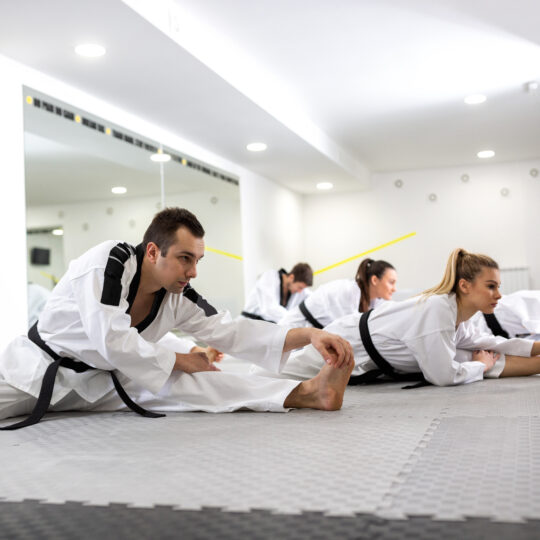What Are Some Stretches That Can Improve Kick Flexibility for Tae Kwon Do?

Emphasis on kicking is one of the things that separates Tae Kwon Do from other martial arts, like Karate. We do a *lot* of kicks here in Tae Kwon Do, and while there are also punches, blocks, and other moves, kicks are how many people recognize Tae Kwon Do from many of the other programs.
But it’s not just kicks. Flexibility is also a critical component of Tae Kwon Do, as high, precise, and powerful kicks require a full range of motion in the hips, hamstrings, and other muscle groups. For those looking to improve their kicks, incorporating targeted stretches into your training routine can help improve kick flexibility, reduce injury risk, and enhance overall performance.
Stretches for Tae Kwon Do Kicks
One thing to keep in mind is that we will help with stretches as part of your TKD program, so you or your child will get direction on warming up and making sure your kicks become more flexible. But for those that are really committed to Tae Kwon Do, you can try stretching on your own.
Before engaging in static stretching, it’s important to warm up your muscles. Dynamic stretches can help increase blood flow and prepare your body for deeper flexibility work. Examples include:
- Leg Swings – Stand near a wall or support and swing one leg forward and backward in a controlled motion, keeping the leg straight. Perform 10-15 swings on each leg to loosen the hip flexors, hamstrings, and glutes.
- Side Leg Swings – Swing your leg side to side across your body, targeting the inner thigh and hip abductors. Keep your torso upright and perform 10-15 swings per leg.
- Knee-to-Chest Walks – While walking forward, pull one knee toward your chest, then alternate legs. This helps activate the hip flexors and stretches the glutes.
After warming up, static stretches can be used to gradually lengthen muscles and improve range of motion. These stretches should be held for 20-30 seconds and performed after training or as part of a dedicated flexibility session.
- Standing Hamstring Stretch – Place one leg on an elevated surface like a chair or bar, keeping the leg straight. Lean forward from the hips while maintaining a straight back to stretch the hamstrings.
- Hip Flexor Stretch – Kneel on one knee with the other foot planted in front, forming a 90- degree angle. Shift your weight forward to feel a stretch in the hip flexor of the kneeling leg.
- Butterfly Stretch – Sit on the floor with the soles of your feet pressed together and knees falling outward. Gently push your knees closer to the ground to stretch the inner thighs and groin.
- Side Lunge Stretch – Stand with your legs wide apart and lunge to one side, keeping the other leg straight. This stretch targets the inner thighs and hip adductors.
Those stretches will help begin your quest for more flexible kicks. But you can also keep going. As you improve, you’ll look to develop an even more flexible kick range. For those looking to improve their high kick range, advanced stretches can help develop extreme flexibility over time, such as:
- Front Split Stretch – Slide one leg forward and the other back into a split position. Use props like yoga blocks for support if you’re unable to achieve a full split initially.
- Pigeon Pose – From a plank position, bring one knee forward and place it near your opposite wrist, with the shin angled across your body. Extend the other leg behind you and lower your torso to deepen the stretch in the glutes and hip flexors.
- Frog Stretch – Position yourself on all fours and slide your knees outward while keeping your feet in line with your knees. Lower your body to feel a deep stretch in the inner thighs and groin.
Always warm up before static stretching to avoid injury. Gradually increase the intensity and duration of stretches over time. Avoid bouncing or forcing your body into positions beyond its current capacity. Maintain proper posture and alignment during each stretch to maximize effectiveness.
Building Flexibility Over Time
Improving kick flexibility requires consistency and patience. By integrating these stretches into your regular training routine and progressing gradually, you can enhance your flexibility and execute Tae Kwon Do kicks with greater precision and power.